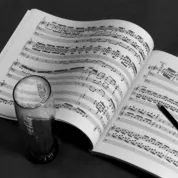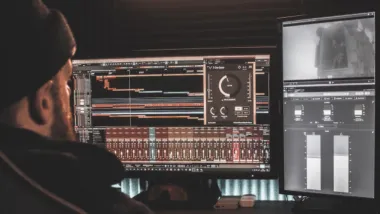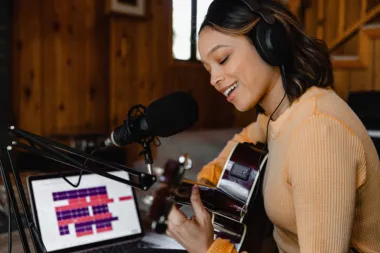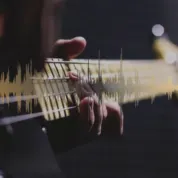
While becoming a chart-topping songwriter like Ed Sheeran may require a rare blend of creativity and skill, the fundamental process of writing a song is surprisingly not that difficult. Songwriting is a flexible and fluid process that people of varying creative levels can easily adapt to. So, if you're a total beginner or a seasoned musician who just hasn't tried songwriting yet, this guide on how to write a song will make it easy for you.
Musicians often start this creative journey by noodling around with a guitar riff or a piano melody. They may then add a chord progression, lay down some instrumental groundwork, and add lyrics later. This guide adopts a similar music-first approach, so musicians will have no trouble following it step-by-step. Vocalists, however, may prefer to start with lyrics or work on both music and vocals simultaneously. If that's more your style, feel free to start with section titled "Part 2: Writing the Lyrics", and then move on to "Part 1: Writing the Musicts catchy, repetitive n". Otherwise, let's get started learning how to write a song by brainstorming the genre of our next song!
Part 1: Writing the Music

1. Decide on a Genre
Choosing a genre is often the first step in the songwriting process. If you're already a musician, you likely already have a favorite genre you play most often. Whether it's rock, pop, country, or techno, each genre comes with its unique set of instruments, vocal styles, and themes. In rock, for instance, power chords and rebellious themes might dominate, whereas in country music you may want to use a steel guitar and sing about booze and heartache.
Sometimes, the emotional tone of the song can dictate the genre; a love song might naturally fall into a slow, romantic genre, while an angry song might be more hardcore. Furthermore, if you're a vocalist and you start by writing the lyrics, the genre could be more fluid and interchangeable. Meanwhile, musicians who kickstart the process with a melody often find that the genre is more or less predetermined by their initial musical ideas.
2. Create a Melody
For many guitarists, especially those that learn to play while jamming with friends, coming up with catchy guitar riffs is something done all the time. It's also a great initial step when learning how to write a song. For others it may take a little practice. You'll want to play around, trying to come up melodies on an instrument you're comfortable with. For most that's a guitar, piano, or keyboard, which are instruments that allow for easy experimentation.
Most of the time it's best to stay in commonly used keys like G, A, C, D, E, and F, as that will make the rest of the process smoother. You can always transpose to a different key later once you start creating your chord progressions. However, this isn't always easy to do if playing on keys, or if your melody requires open strings on a guitar.
You'll also need to decide whether to go with major scales for a more upbeat and happy tone or minor scales for a melancholic or sentimental mood. For example, D minor is often considered a very 'sad' key, while C major tends to sound more joyful. This will also influence the chord progression you'll write in step 3, so you may wind up revisiting it. Regardless, your main goal should be creating a catchy tune that listeners will remember, as this melody will carry the rest of your song.
3. Choose a Song Structure
Song structure is simply the arrangement of a song, in sections and/or repeating forms. There are multiple advanced song structures and corresponding song parts, but for the sake of article these are the basic parts you need to know:
- Intro: The opening segment that sets the tone for the song.
- Verse: Expands on the song's theme, provides depth and detail.
- Chorus: The catchy and climatic core of the song, usually repetitive.
- Bridge: A contrasting section that adds depth and complexity.
- Outro: The final segment that wraps up the song.
The most commonly used song structure found in popular music is:
Verse / Chorus / Verse / Chorus / Bridge / Chorus
In genres like jazz or prog rock, unconventional structures might be more fitting. But for most music this is a great structure to start with, and especially if you're a beginner.
A bridge isn't always required, but it's very common in many popular genres, as it helps break up the monotony of the verse / chorus repetition. Inserting a bridge adds a contrasting segment that changes the pace and often brings a new perspective or emotional height to the song. Which is especially useful for making your song sound more polished while learning how to write a song.
4. Add a Chord Progression
After determining the primary melody and song structure, you can now move on to harmonizing it. If you're new to songwriting, start with a basic chord structure that supports your verses and chorus without overshadowing the melody or lyrics. For example, the most common chord progression in rock music is the I-IV-V progression. In the key of C, this would be C, F, G.
As you progress, feel free to add secondary melodies or chord progressions to heighten the emotional impact. This could serve as a segue between the vocal lines, or just add a bit of flair to the song. Moreover, you might find it beneficial to start working on the lyrics at this point while learning how to write a song. The relationship between chords and lyrics is often interdependent, and you might need to adjust your chords to better fit the lyrics you write.
5. Develop a Bridge (Optional)
Creating a bridge provides an opportunity for you to step away from the repetitive nature of the verses and choruses. This is the time to experiment with different chords, perhaps even modulate to a new key. The bridge often provides a moment of reflection or an emotional climax in the song. Some songwriters find that adding a bridge can be the element that turns a good song into a great one, transforming it from monotonous to dynamic.
Part 2: Writing the Lyrics

1. Choose a Song Title
Choosing a title is the cornerstone of your songwriting process. A title like “Heartbreak Hotel” by Elvis Presley poses questions like, "What is the Heartbreak Hotel?", "What happens there?", and "Where is it?", which are all answered within the song. It helps you define the premise and sets the stage for the lyrics. Sometimes, you might get inspiration from pop culture, a phrase you've heard, or even an emotion you're feeling. For example, a title like "Shallow" from Lady Gaga and Bradley Cooper's song encapsulates the emotional depth and dynamics they explore.
When learning how to write a song it's important to understand the title can sum up what you want to express in a succinct way, like Taylor Swift's "Love Story," which immediately suggests a romantic theme. The idea is that your title should be compelling and serve as a compass that guides all other elements of your song.
2. Come up with a Hook
The hook may be the most enjoyable part of learning how to write a song. It can also be the most challenging. This is that part of the song that you just can't get out of your head. It's the "Bad Guy, Duh" in Billie Eilish's "Bad Guy" or the "I wanna hold your hand" in The Beatles' song. Its catchy, repetitive nature is what often turns a song into a hit. The hook can sometimes be a lyrical phrase that sums up the essence of the song or a musical riff that stands out.
Consider the hook in Carly Rae Jepsen’s "Call Me Maybe" for example:
Hey, I just met you and this is crazy/But here's my number, so call me maybe
This lyric perfectly captures the emotional rush and vulnerability of giving your number to someone for the first time. The hook is so important that even if other elements of your song are not as strong, a memorable hook can make your song a hit. It's the cornerstone that nearly every top-40 hit song is built upon.
3. Add a Chorus Around Your Hook
A chorus is like the foundation that supports your hook. While a hook could be a part of your chorus, they're not always the same thing. Your chorus is where you generally spell out the song's emotional or narrative core, often in a way that's designed for sing-along, like Queen's "We Will Rock You." The chorus is more like the summarizing statement, while the hook is the headline. For example, in Michael Jackson’s "Billie Jean," the chorus ("Billie Jean is not my lover") envelops the hook ("She's just a girl who claims that I am the one"). If your hook is strong enough, like Neil Diamond’s “Sweet Caroline,” sometimes you don’t need an elaborate chorus; the hook itself does all the work.
4. Create a Verse
The verse is where you add depth and context to your song. Its job is to elaborate on the themes or emotions hinted at in the chorus. For example, if your chorus broadly declares love, the verse can explain the specific reasons for that love, like special moments or unique traits.
Take "Hotel California" for example by the Eagles. It's chorus memorably says "Welcome to Hotel California", telling us little more than it's a lovely place. But its verse expands upon that, in detailed and interesting ways that fans have discussed for decades.
On a dark desert highway Cool wind in my hair Warm smell of colitas Rising up through the air Up ahead in the distance I saw a shimmering light My head grew heavy and my sight grew dim I had to stop for the night...
Your verse serves as a pathway back to the chorus, building tension or interest that naturally resolves or explodes into the chorus. It shouldn't feel like filler. Instead, it should offer new information or a different emotional shade, pulling the listener back into the main hook when the chorus returns. To accomplish this while learning how to write a song, make sure both the lyrics and the musical arrangements in the verse complement the chorus, rather than compete with it.
5. Write Lyrics for Verses
Now that you've set the stage with your first verse, the subsequent verses should continue to add depth, detail, or a different perspective to what you've already established. For example, in Bob Dylan’s "Like a Rolling Stone," each verse tells a different part of the story but contributes to the same overarching theme. Make sure to follow the same lyrical and melodic patterns you established in your first verse to keep the song cohesive. This is your chance to expand on the story or emotions you touched upon initially, and a great place to answer any questions posed by your title or initial verse.
If you started off not knowing how to write a song at all, by this point you should have a good idea of what it takes. Of course committing it to memory after you've written it isn't enough. In the next section, will discuss all of the steps needed to get it recorded as well.
Part 3: Recording

1. Choose Your Music Production Software
If this is your first time learning how to write a song, or you're just starting out with recording music, the choice of software can be overwhelming. There are several big players like Ableton Live, Pro Tools, FL Studio, and Cubase, each offering a unique workflow and feature set. These are the leading full-featured Digital Audio Workstations (DAWs) that you can read our thorough review of here.
For those new to the recording process, GarageBand is an excellent starting point. And you'd be surprised how many accomplished musicians use it as well, for drafts and smaller projects. It offers the easiest to use UX of any recording software, and a lot of tools to help streamline the process. While not as full-featured as the DAWs we featured here, it has enough features to create a polished sound without overwhelming you with options. In addition to those mentioned above, advanced users may also opt for Logic Pro, which is like GarageBand's more sophisticated sibling, offering extensive sound libraries, advanced editing, and mixing features.
2. Record the Instrumentals
Recording instrumentals is a nuanced process that serves as the backbone of your song. Typically, you start with the drums to set the tempo and build a rhythmic foundation. Software like GarageBand can even auto-generate drum lines if you're not versed in percussion.
Once the drum track is solid, you'll add the bass to fill in the low-end frequencies and complement the drum patterns. Then come the rhythm instruments like guitars and keyboards, followed by lead instruments for the melody or solos. Each layer should be recorded separately to provide room for precision during the mixing process.
Sound design plays a key role here, as the plugins you choose—be it reverb for an 80s vibe or high-speed trap hi-hats—can define the era and mood of your song. And don't forget, a seasoned producer can be invaluable in helping you blend your influences into a unique sonic tapestry. So go ahead, layer those tracks and create a piece of music that's distinctly yours.
3. Arrange and Edit
Arranging and editing are pivotal stages in crafting a song. It's where you frame your musical ideas into a more structured form. After you've recorded the raw elements, use your Digital Audio Workstation to arrange them into verses, pre-choruses, choruses, bridges, and so on. During this stage, make sure that the song's tempo (BPM) is consistent and fits the mood you aim to evoke.
But arranging isn't just about the order of parts; it's also about making the song interesting. Cut, copy, and paste your tracks to experiment with different arrangement ideas. You can also import pre-recorded samples into your song to add sound clips without playing an instrument. Sampling, which used to only be used in Hip-Hop, have become common place across all modern, popular music. We have a review of the top 10 sample libraries, as well as a head-to-head comparison of Loopcloud and Slice the two most commonly used sample libraries.
A good practice while editing is to strip down sections to let the vocals shine, and build up other sections for dynamic shifts. Your goal is to keep the listener hooked from start to finish. Pay special attention to transitions. They can make or break the flow. Use effects like sweeps, filters, or instruments to link different parts smoothly. This is also the time to tighten up your timing; align your tracks to ensure they're in perfect sync with your BPM.
4. Record the Vocals
Vocals are often considered the soul of a song, especially in genres where the lyrics carry significant weight. If this is your first time learning how to write a song, before you step into the recording booth, make sure you know your song inside out. You're not just recording words; you're conveying emotions. Be prepared to perform multiple takes. A producer will often encourage you to explore different emotional tones or delivery styles until you hit the one that complements the song best.
Once you've nailed the primary vocal line, it's time to add layers. Double-tracking is common—recording the same line twice to give it more weight. Don't overlook harmonies; they can add a rich complexity to your vocal arrangement. Post-recording, you'll go through a processing phase which includes tuning, equalization, and compression to make sure your vocals fit well in the mix.
5. Mixing
After you've completed the recording, it's time for mixing, which is an art form in itself. This stage involves adjusting and combining individual tracks to craft a unified and polished final audio product. Each element, whether it's a vocal line or an instrument, should have its own 'space' in the audio spectrum. You'll be cutting unnecessary frequencies and adjusting dynamics to ensure everything fits together seamlessly. Effects like reverb and delay are applied to give the mix a sense of space.
A skilled producer will use reference tracks, songs that have a similar sound to what you're aiming for, to ensure the mix is up to industry standards. Automation is often used to dynamically adjust the volume and effects parameters to better suit the song's emotional arc. The ultimate goal of mixing is to ensure all the parts complement each other. Once you're satisfied with the mix, it will be exported into an audio file format like WAV or MP3, ready for mastering.
In the words of Leonard Cohen...
If I knew where the good songs came from, I’d go there more often.
Learning how to write a song is not just a composition of notes and words; it's a journey into the uncharted territories of the songwriter's thoughts and emotions. It's a form of storytelling where the pen is your voice and the melody is your emotion. Once you master it you'll need other musicians to help you showcase your music to the world! We also have articles to help you learn how to start a band, and everything you need to know about music in the digital age. You'll also need to know how to market and promote it, and how to gain traction on Social Media and go viral on TikTok. As an independent musician, Band Pioneer has all of your bases covered!
This songwriting guide offers a structured path to help get you started. But keep in mind that some of the greatest songs have come from moments of completely unstructured inspiration, and even chaos. As you take these steps to write your own song, don't forget to listen to yourself and to the world around you. Enjoy the songwriting journey with an open mind and heart, and you'll love the final product, a song that's uniquely yours.







Leave a Reply!